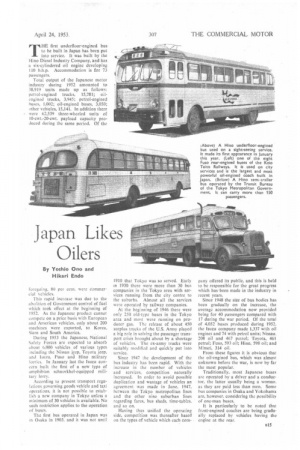Japan Likes Oilers
Page 49

If you've noticed an error in this article please click here to report it so we can fix it.
By Yoshio Ono and Hikari Endo THE first underfioor-engined bus to be built in Japan has been put into service, It was built by the [lino Diesel Industry Company, and has a six-cylindered oil engine developing 110 b.h.p. Accommodation is for 73 passengers.
Total output of the Japanese motor industry during 1952 amounted to 38,919 units made up as follows: petrol-engined trucks, 15,781; oilengined trucks, 3,945: petrol-engined buses, 1,002; oil-engined buses, 3,050; other vehicles, 15,141. In addition there were 62,539 three-wheeled units of 10-cwt.-20-cwt. payload capacity produced during the same period. Of the
foregoing, 80 per ceni. were Commcrelal vehicles.
This rapid increase was due to the abolition of Government control of fuel which took effect at the beginning of 1952. As the Japanese product cannot compete on a price basis with European and American vehicles, only about 200 machines were exported, to Korea, Siam and South America.
During 1953 the Japanese, National Safety Forces are expected to absorb about 6,000 vehicles of various types including the Nissan jeep, Toyota jeep, and [sum, Fuso ana Hino military lorries. In January last the Istizu concern built the first of a new type of amphibian schnorkhel-equipped military lorry.
According to present transport regulations governing goods vehicle and taxi operations, it is not possible to establish a new company in Tokyo unless a minimum of 30 vehicles is available. No such restriction applies to the operation of buses.
The first bus operated in Japan was in Osaka in 1903. and it was not until
1910 that Tokyo was so served. Early in 1930 there were more than 30 bus companies in the Tokyo area with services running from the city centre to
the suburbs, Almost all the services were operated by railway companies.
At the beginning of 1946 there were only 250 old-type buses in the Tokyo area and most were running on producer gas. The release of about 450 surplus trucks of the U.S. Army played a big role in solving the passenger transport crisis brought about by a shortage of vehicles. The ex-army trucks were suitably modified and quickly put into service.
Since 1947 the development of the bus industry has been rapid. With the increase in the number of vehicles and services, competition naturally increased. In order to avoid possible duplication and wastage of vehicles an agreement was made in June, 1947, between the Tokyo metropolitan lines and the other nine suburban lines regarding fares, bus sheds, time-tables, and so on.
Having thus unified the operating side, competition was thereafter based on the types of vehicle which each coin
pany offered its public, and this is held to be responsible for the great progress which has•been made in the industry in recent years.
Since 1948 the size of bus bodies has been gradually on the increase, the average accommodation now provided being for 40 passengers compared with 17 during the war period. Of the total of 4,052 buses produced during 1952. the Isuzu company made 1,337 with oil engines and 74 with petrol units; Nissan. 208 oil and 467 petrol; Toyota, 461 petrol; Fuso, 593 oil; Hino, 598 oil; and Minsei, 314 oil_ From these figures it is obvious that the oil-engined bus, which was almost unknown before the war, is now by far the most popular.
Traditionally, most Japanese buses are operated by a driver and a conductor, the latter usually being a woman. as they are paid less than men. Some bus companies in Osaka and Yokohama are, however, considering the possibility of one-man buses.
It is particularly to be noted that front-engined coaches are being gradually replaced by vehicles having the engine at the rear.




































































































